-
Tel : +8618150976625
-
Email : Hello@MicrofiberLeather.com
Tel : +8618150976625
Email : Hello@MicrofiberLeather.com
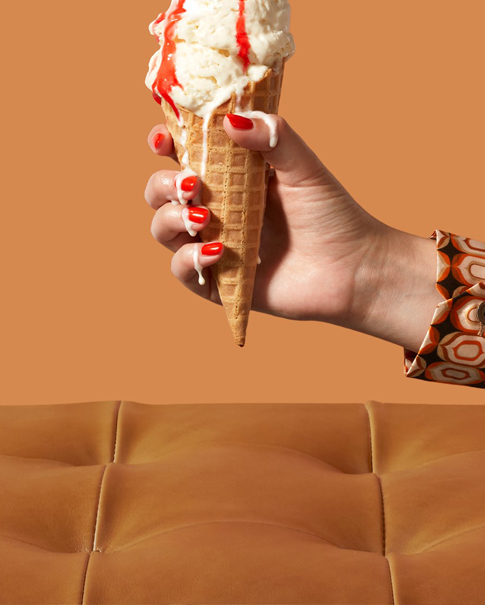
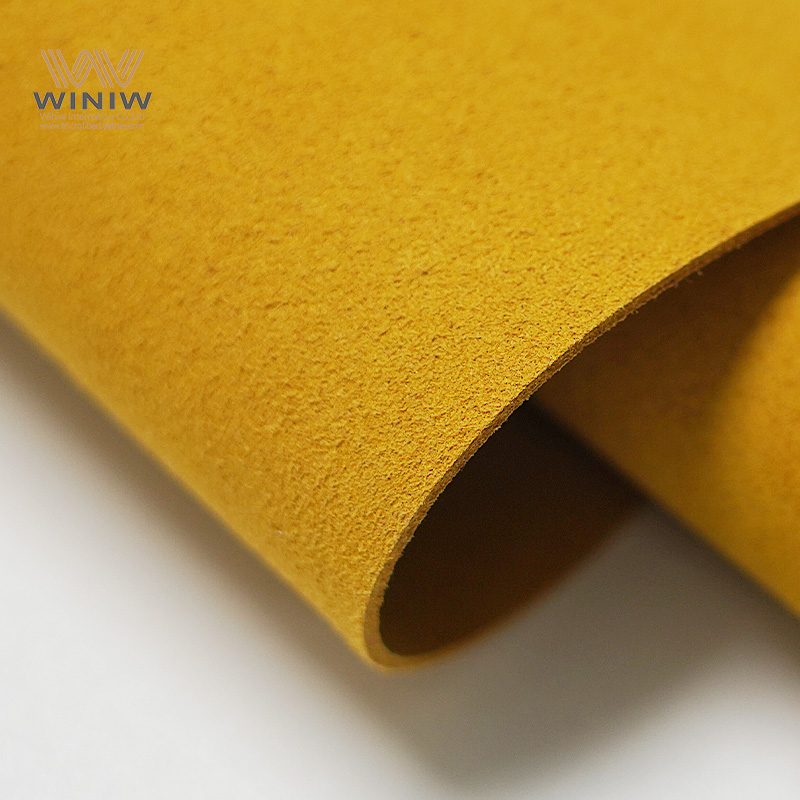
Choosing between microfiber suede and real suede often comes down to balancing practicality with personal preference. Microfiber suede stands out for its easy maintenance, affordability, and water resistance, while real suede offers a unique tactile experience and luxurious appeal. The following table highlights key differences:
|
Feature |
Microfiber Suede |
Real Suede Fabric |
|---|---|---|
|
Durability |
High |
Moderate, needs care |
|
Maintenance |
Simple |
Specialized cleaning |
|
Water Resistance |
Good |
Poor |
|
Affordability |
Accessible |
Premium |
Many consumers now favor faux suede and microfiber options for their versatility and sustainability, especially in fashion and upholstery. However, some still value the authenticity and softness of real materials. Each option meets different needs, so shoppers should consider budget, lifestyle, and values before making a decision.
Microfiber suede is durable and easy to clean, making it ideal for busy households and high-traffic areas.
Real suede offers a luxurious feel and unique texture, appealing to those who value authenticity and craftsmanship.
Microfiber suede is more affordable than real suede, providing a stylish option without breaking the bank.
Real suede requires special care and maintenance to preserve its beauty, while microfiber suede is low-maintenance.
Microfiber suede is water-resistant, making it suitable for environments where spills are common.
Real suede has a natural look with unique variations, while microfiber suede offers consistent color and texture.
Choosing microfiber suede supports eco-friendly practices, as it often uses recycled materials and avoids animal products.
Consider your lifestyle and values when choosing between microfiber and real suede to find the best fit for your needs.
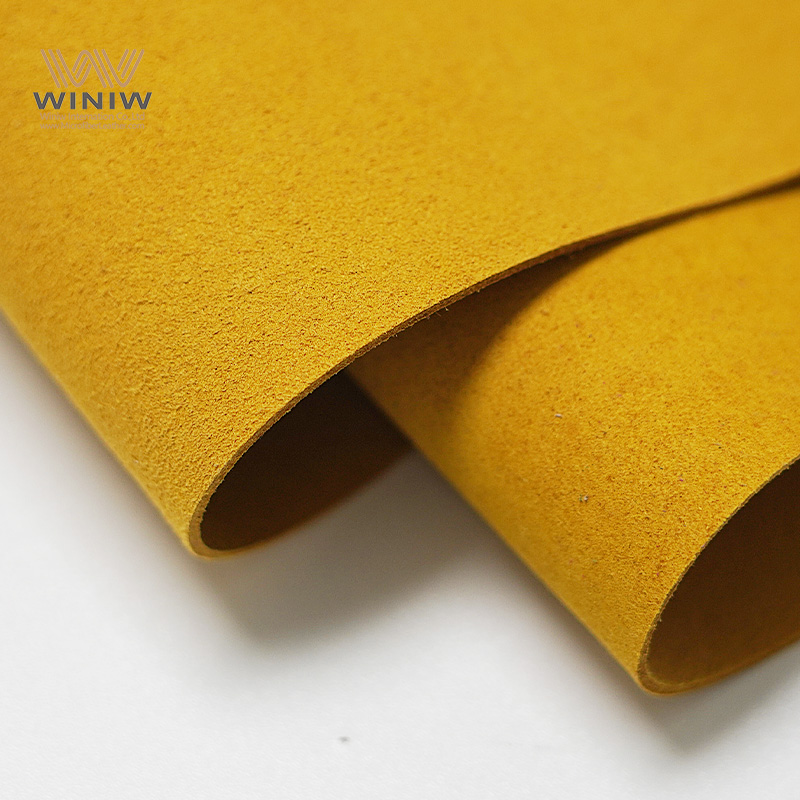
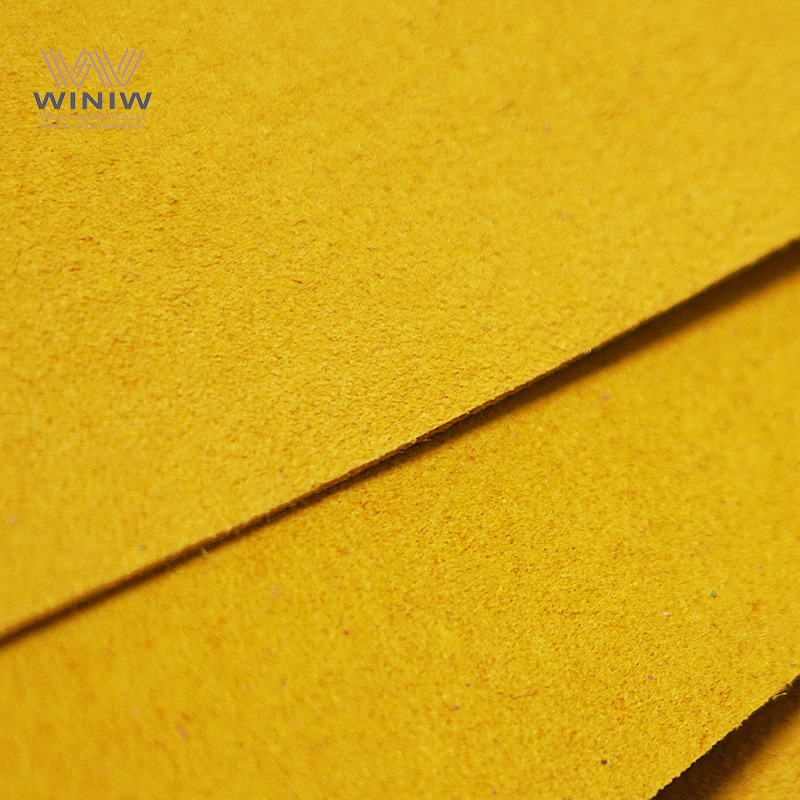
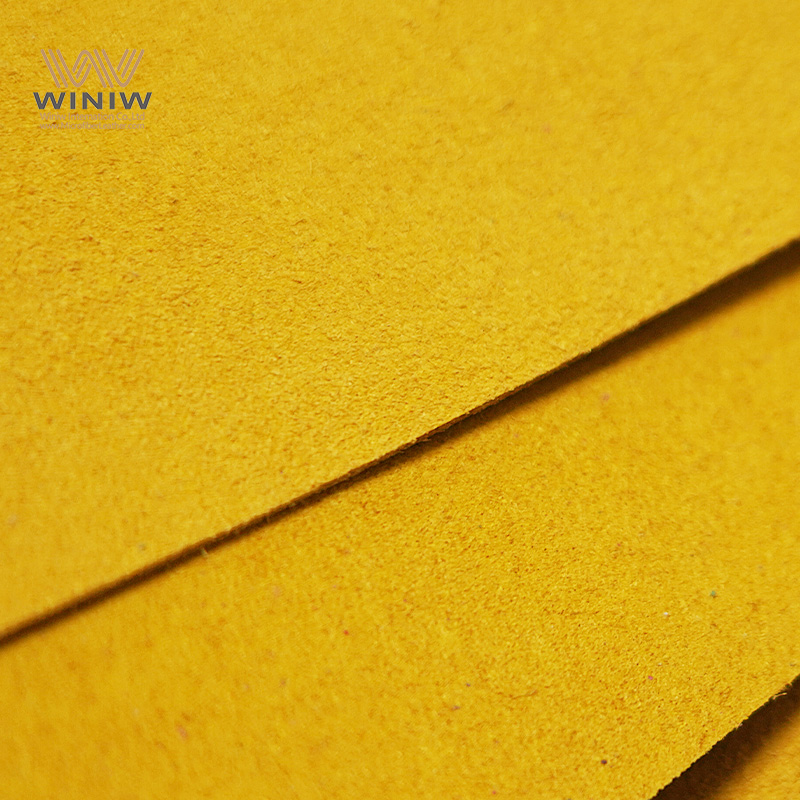
The following table provides a concise overview of the pros and cons for both microfiber suede and real suede. This comparison helps readers quickly identify which material best suits their needs.
|
Aspect |
Microfiber Suede |
Real Suede |
|---|---|---|
|
Durability |
Resistant to wear and tear |
Prone to scuffs and stains |
|
Maintenance |
Requires special care and cleaning |
|
|
Water Resistance |
Good water resistance |
Absorbs moisture easily |
|
Cost |
More affordable |
Higher price point |
|
Appearance |
Consistent texture and color |
Natural variation, luxurious look |
|
Sustainability |
Animal-based, less sustainable |
Tip: Microfiber suede offers practical benefits for busy lifestyles, while real suede appeals to those who value authenticity and tactile luxury.
Microfiber suede fabric represents a modern alternative to traditional suede. Manufacturers create this material by weaving ultra-fine synthetic fibers, often polyester or polyamide, into a dense structure. Faux Leathers produces micro fiber leather using advanced technology, combining a polyurethane surface layer with a microfiber base. This process results in a fabric that closely mimics the appearance and texture of genuine suede.
Microfiber suede fabric stands out for its uniform texture and consistent color. The tightly woven fibers provide a soft, velvety surface that feels comfortable to the touch. The material resists scratches and stains, maintaining its appearance over time. Faux Leathers' micro fiber leather offers breathability, making it suitable for various climates. The fabric remains lightweight, which simplifies handling and installation.
A key advantage of microfiber suede fabric lies in its durability. The synthetic fibers withstand daily wear and tear, making the material ideal for high-traffic environments. The fabric also demonstrates excellent water resistance, reducing the risk of damage from spills or moisture. Cleaning requires minimal effort, as most stains can be removed with a damp cloth. Faux Leathers ensures that their micro fiber leather meets international safety and environmental standards, providing peace of mind for consumers.
|
Feature |
Microfiber Suede Fabric |
|---|---|
|
Texture |
Soft, velvety, consistent |
|
Durability |
High resistance to wear |
|
Water Resistance |
Excellent |
|
Maintenance |
Easy to clean |
|
Weight |
Lightweight |
|
Customization |
Wide range of colors and textures |
Note: Microfiber suede fabric offers a practical solution for those seeking the look and feel of suede without the challenges of maintenance and cost.
Microfiber suede fabric finds application in many industries. Upholstery manufacturers use it for sofas, chairs, and automotive interiors due to its durability and easy care. Fashion designers select microfiber suede fabric for handbags, shoes, and accessories, appreciating its versatility and aesthetic appeal. The material also appears in sports equipment, such as balls and gloves, where resistance to abrasion is essential.
Faux suede fabric uses extend to home décor, including cushions, curtains, and wall coverings. The fabric's lightweight nature and customizable appearance make it popular for DIY projects and crafts. Faux Leathers' micro fiber leather supports sustainable practices, as it does not rely on animal products and often incorporates recycled materials.
Microfiber suede fabric suits both personal and commercial needs. Businesses value its long lifespan and low maintenance requirements. Individuals appreciate the comfort and style it brings to everyday items. The combination of affordability, durability, and eco-friendly production positions microfiber suede fabric as a preferred choice for modern consumers.
Tip: Explore faux suede fabric uses in your next project to enjoy a blend of style, practicality, and sustainability.
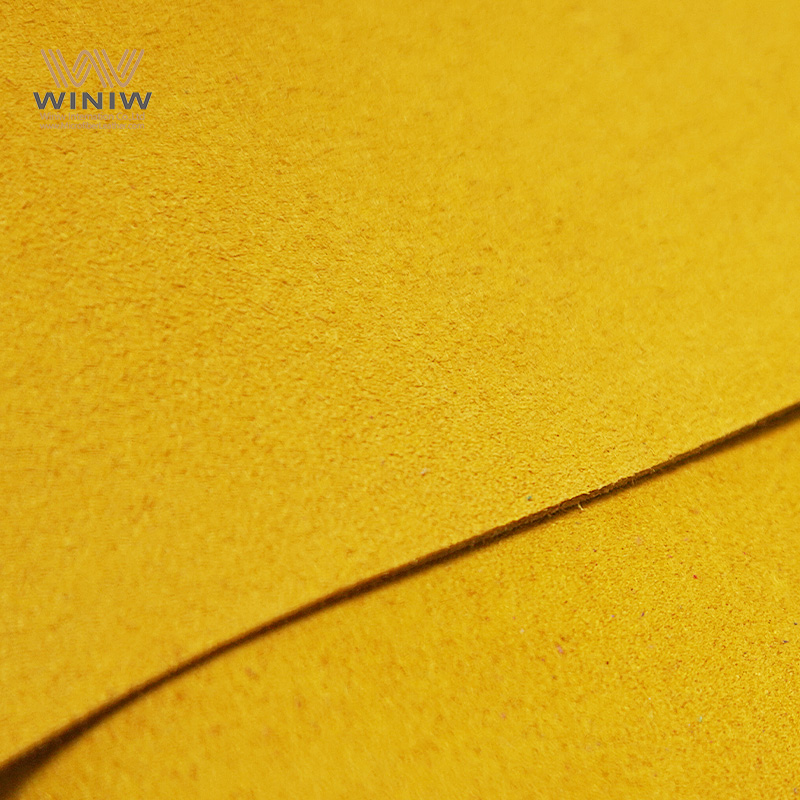
Real suede comes from the underside of animal hides, most commonly from cows, goats, or pigs. Tanners process the inner split of the hide to create a soft, napped finish. This process gives real suede its signature texture and appearance. Real suede explained simply: it is a type of leather that features a velvety surface, created by buffing the inner layer of the hide. The fibers stand up, producing a plush, tactile feel that many people associate with luxury.
Natural suede leather stands out for its unique grain and subtle imperfections. Each piece of real suede displays slight variations in color and texture. These differences add character and authenticity. Traditional suede has a matte finish and feels supple in the hand. The material remains breathable, which makes it comfortable for clothing and accessories. Real suede also absorbs dyes well, resulting in rich, deep colors.
Manufacturers value real suede for its flexibility and softness. The material drapes well and molds to shapes over time. However, real suede requires careful handling. The open fiber structure makes it more susceptible to stains and water damage than other leathers. Proper care helps preserve its beauty and extends its lifespan.
Note: Real suede offers a natural, luxurious look that synthetic alternatives often try to replicate, but rarely match in authenticity.
Real suede appears in a wide range of products. Fashion designers use suede for jackets, skirts, shoes, and handbags. The soft texture and elegant appearance make it a favorite for high-end accessories. Many people choose real suede gloves and hats for their warmth and comfort.
Furniture makers often select real suede for upholstery. Sofas, chairs, and cushions covered in suede add a touch of sophistication to living spaces. The material feels inviting and looks refined. Car manufacturers sometimes use real suede for interior panels and seats, especially in luxury vehicles.
Artisans and crafters appreciate real suede for its workability. The material cuts and sews easily, making it suitable for custom projects. Jewelry makers use suede strips for necklaces and bracelets. Bookbinders sometimes choose suede for covers, valuing its tactile quality.
The appeal of real suede lies in its natural beauty and timeless style. People who value authenticity and craftsmanship often prefer real suede over synthetic options. The material’s unique character and luxurious feel continue to attract those seeking something special.
Tip: When selecting products made from real suede, consider the environment and intended use. Real suede suits items that benefit from softness and elegance, but may not be ideal for heavy-duty or outdoor applications.
The appearance of suede plays a major role in its appeal. Real suede offers a natural, luxurious look with subtle variations in color and grain. Each piece of real suede displays unique markings and slight imperfections. These characteristics give real suede a high-end appearance that many people associate with premium products. The surface often shows a soft sheen under light, enhancing its visual depth.
Faux suede material, such as Faux Leathers' micro fiber leather, closely mimics the suede-like appearance of genuine suede. Manufacturers engineer microfiber suede to achieve a consistent color and uniform finish. This consistency appeals to designers who want predictable results across large projects. Faux suede material can be produced in a wide range of colors, allowing for more creative freedom. The suede-like appearance remains stable over time, resisting fading and discoloration.
|
Feature |
Real Suede |
Faux Suede (Microfiber Suede) |
|---|---|---|
|
Color Variation |
Natural, unique |
Consistent, customizable |
|
Surface Sheen |
Subtle, changes with light |
Matte or soft sheen, uniform |
|
High-End Appeal |
Yes |
Yes, especially with quality faux |
Note: The high-end appearance of real suede attracts luxury brands, while the reliable suede-like appearance of microfiber suede appeals to modern designers.
Texture defines the tactile experience of suede. Real suede feels soft, supple, and slightly fuzzy. The nap, or raised fibers, creates a plush sensation when touched. This texture changes depending on the direction of the stroke, adding to the sensory appeal. Many people find the texture of real suede comforting and warm.
Microfiber suede, used in Faux Leathers' products, replicates this texture with remarkable accuracy. The ultra-fine fibers in microfiber create a velvety surface that feels smooth and gentle. Faux suede material maintains a consistent texture across every piece, which is why designers love faux suede for projects that require uniformity. Unlike real suede, microfiber suede resists flattening and matting, even after repeated use.
Real suede: Soft, plush, variable nap
Microfiber suede: Smooth, even, durable nap
Tip: For projects that demand a consistent texture, microfiber suede offers a practical solution without sacrificing comfort.
Aging affects the appearance and performance of both real and faux suede materials. Real suede develops a patina over time. The surface may darken in areas of frequent contact, and the nap can flatten or become shiny. These changes add character but may also highlight wear and tear. Real suede requires careful maintenance to preserve its original look.
Microfiber suede ages differently. The synthetic fibers resist most signs of aging, such as fading, staining, or matting. Faux Leathers' micro fiber leather maintains its suede-like appearance and texture for years, even in high-traffic environments. The material does not develop a patina, so it retains a fresh look with minimal care. This durability makes microfiber suede a preferred choice for items that need to look new for longer.
Block Quote: Microfiber suede offers long-lasting beauty and performance, while real suede develops a unique character as it ages.
Microfiber suede demonstrates impressive durability in demanding environments. Manufacturers engineer microfiber to withstand daily wear and tear, making it a preferred choice for upholstery, automotive interiors, and fashion accessories. Faux Leathers' micro fiber leather offers a unique combination of soft feel and durability, which appeals to both designers and consumers. The tightly woven structure of microfiber resists scratches, scuffs, and stains. This resistance ensures that products maintain their appearance even after frequent use.
Microfiber suede also excels in water resistance. The synthetic fibers prevent moisture from penetrating the surface, reducing the risk of damage from spills or humidity. This feature makes microfiber suitable for households with children or pets, as well as commercial spaces with high foot traffic. Cleaning microfiber suede requires minimal effort. Most stains can be removed with a damp cloth, and the material does not require specialized cleaning products.
Note: Faux Leathers' micro fiber leather stands out for its ability to retain its soft feel and durability over time, even in challenging conditions.
Microfiber suede remains lightweight, which adds to its versatility. The material adapts well to different shapes and applications. Designers appreciate the consistent texture and color, which simplifies large-scale projects. Microfiber maintains its integrity without fading or matting, ensuring a long lifespan for finished products.
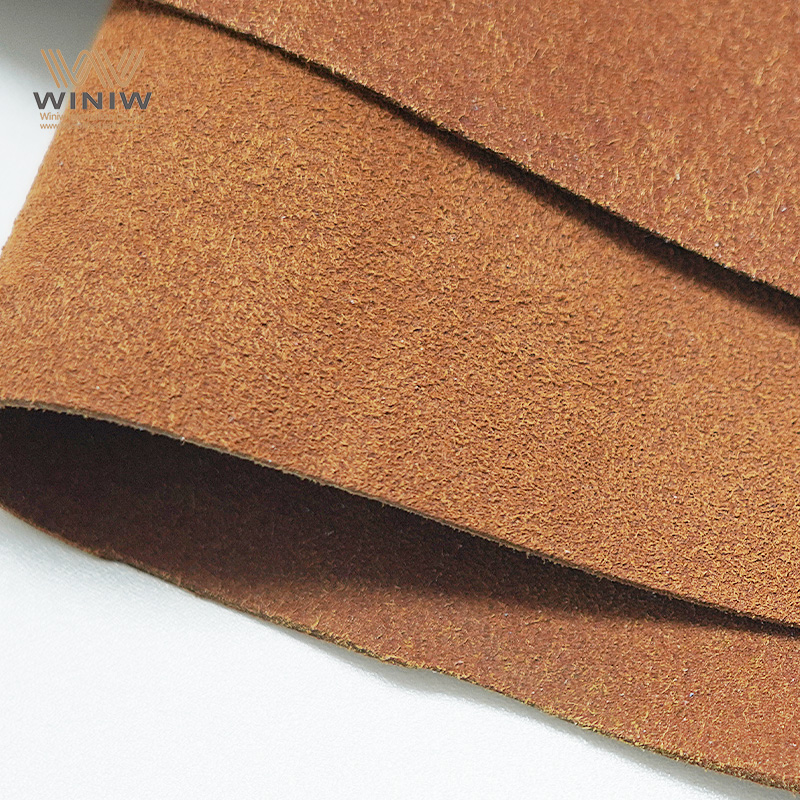
Real suede offers a luxurious texture and natural beauty, but its durability depends on careful handling and maintenance. The open fiber structure of real suede creates a soft, plush surface, but it also makes the material more vulnerable to wear. Scuffs, stains, and water damage can occur easily if the suede is exposed to rough conditions. Real suede absorbs moisture quickly, which may lead to discoloration or permanent marks.
The durability of real suede varies based on the quality of the hide and the tanning process. High-quality real suede provides a soft feel and durability for fashion items like jackets, shoes, and handbags. However, regular care is essential. Owners must use specialized cleaning products and avoid exposing real suede to water or harsh environments. Over time, real suede develops a patina, which adds character but may also highlight signs of aging.
|
Material |
Resistance to Wear |
Water Resistance |
Maintenance Needs |
Lifespan |
|---|---|---|---|---|
|
Microfiber Suede |
High |
Excellent |
Low |
Long-lasting |
|
Real Suede |
Moderate |
Poor |
High |
Variable |
Real suede remains popular for its authentic look and tactile experience. Many consumers value the soft feel and durability of premium suede, especially in luxury goods. However, those seeking long-term performance in high-traffic areas may prefer alternatives like faux suede or microfiber suede.
Tip: Choose real suede for items that benefit from its unique texture and appearance, but consider microfiber suede for projects that demand maximum durability and easy care.
Microfiber suede stands out for its straightforward maintenance. Faux Leathers' micro fiber leather offers a surface that resists stains and moisture, making it easy to clean. Users can remove most spills with a damp cloth, which simplifies daily upkeep. For more stubborn marks, a mild soap solution works well. The tightly woven microfiber structure prevents dirt from penetrating deep into the fabric, so regular wiping keeps the material looking fresh.
Many consumers appreciate the low-maintenance nature of microfiber suede. The fabric does not require specialized cleaning products or professional services. Routine care involves simple steps:
Wipe with a damp cloth to remove dust and light stains.
Use mild soap for tougher spots.
Allow the material to air dry after cleaning.
Tip: Microfiber suede maintains its appearance with minimal effort, making it ideal for busy households and commercial spaces.
Faux Leathers' micro fiber leather also resists fading and matting, so the surface remains consistent over time. The material's durability reduces the need for frequent replacements, which adds value for users seeking long-term performance. Microfiber suede suits environments where spills and dirt are common, such as homes with children or pets.
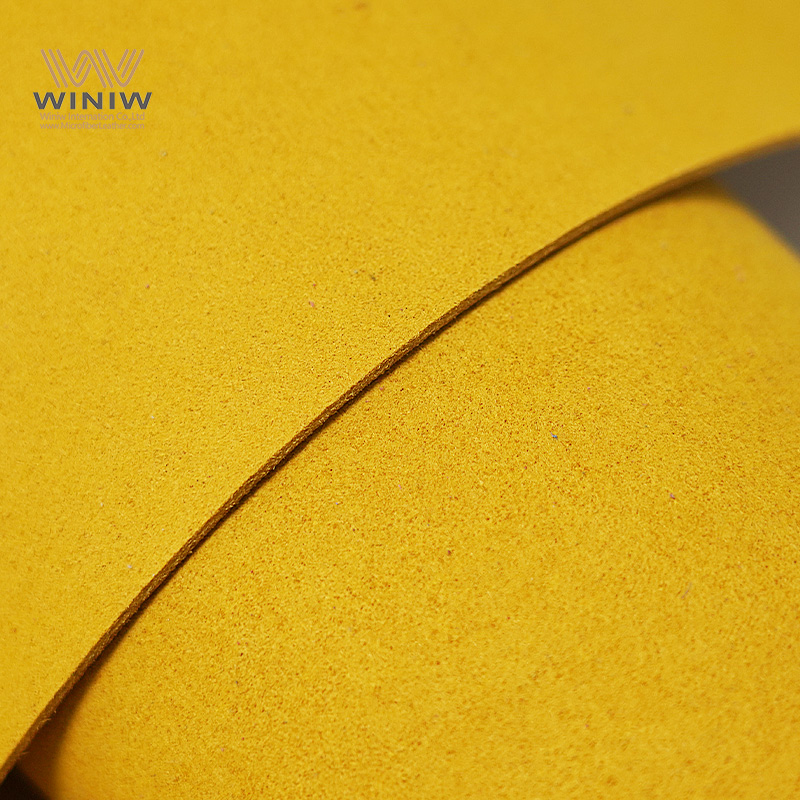
Real suede requires more careful maintenance. The open fiber structure absorbs liquids quickly, so prompt action is necessary when spills occur. Owners should blot, not rub, any moisture to prevent stains from setting. Specialized suede brushes help restore the nap and remove surface dirt. For deeper cleaning, professional services may be necessary.
A typical maintenance routine for real suede includes:
Blotting spills immediately with a clean cloth.
Using a suede brush to lift the nap and remove dust.
Applying suede-specific cleaning products for stains.
Avoiding water and harsh chemicals to preserve texture.
|
Maintenance Task |
Microfiber Suede |
Real Suede |
|---|---|---|
|
Daily Cleaning |
Damp cloth |
Suede brush |
|
Stain Removal |
Mild soap solution |
Suede cleaner |
|
Water Resistance |
High |
Low |
|
Professional Care |
Rarely needed |
Often recommended |
Real suede demands attention to detail. Owners must store items away from direct sunlight and moisture to prevent discoloration. Regular brushing keeps the nap soft and plush. The need for specialized products and techniques increases the time and cost of maintenance.
Note: Microfiber suede offers a practical solution for those who prefer materials that are easy to clean and maintain, while real suede appeals to individuals willing to invest in extra care for a luxurious finish.
When comparing the cost of suede materials, clear differences emerge between real suede and microfiber suede. Real suede comes from animal hides, which require specialized processing and skilled labor. This process increases the cost of real suede products. Consumers often find real suede at a premium price point, especially in high-end fashion and luxury upholstery. The price reflects the natural origin, unique texture, and the craftsmanship involved in producing real suede.
Microfiber suede, on the other hand, offers a more budget-friendly alternative. Manufacturers use synthetic fibers and advanced technology to create microfiber suede. This process allows for greater efficiency and lower production costs. Faux Leathers' micro fiber leather stands out for its affordability, making it accessible to a wider audience. Many shoppers appreciate that they can achieve the look and feel of suede without the high cost associated with real materials.
The following table summarizes the typical price differences:
|
Material |
Average Price Range (per yard) |
Typical Applications |
|---|---|---|
|
Real Suede |
$30 - $80 |
Luxury apparel, upholstery |
|
Microfiber Suede |
$10 - $30 |
Everyday fashion, décor |
Note: Microfiber suede provides a cost-effective solution for those who want the appearance of suede without the expense of real suede.
Value extends beyond the initial cost. Real suede offers a luxurious feel and a unique, natural appearance. Many people consider real suede a long-term investment, especially for items that showcase craftsmanship and style. However, real suede requires ongoing care and maintenance, which can add to the total cost over time. Owners may need to invest in specialized cleaning products or professional services to preserve the material's quality.
Microfiber suede delivers strong value through durability and ease of care. Faux Leathers' micro fiber leather resists stains, fading, and wear, which helps products maintain their appearance for years. The low maintenance requirements reduce ongoing expenses. For consumers who prioritize affordability and longevity, microfiber suede represents an excellent choice. The material suits a variety of uses, from fashion to home décor, without sacrificing style or comfort.
Faux suede also appeals to those who seek sustainable and cost-effective options. The combination of affordability, durability, and versatility makes microfiber suede a smart investment for both individuals and businesses.
Tip: When weighing the value of real suede versus microfiber suede, consider not only the purchase price but also the long-term costs of care and replacement.
Microfiber suede presents a modern alternative for those who prioritize sustainability. Manufacturers produce this material using synthetic fibers, often incorporating recycled content. Faux Leathers' micro fiber leather stands out in the market for its eco-friendly production process. The company avoids animal-derived ingredients and uses advanced technology to minimize waste. This approach reduces the environmental footprint compared to traditional leather manufacturing.
Microfiber suede requires less water and fewer chemicals during production. The absence of tanning agents, which often contain hazardous substances, benefits both workers and the environment. The lightweight nature of microfiber also means lower transportation emissions. Many designers choose this alternative for its durability, which extends product life and reduces the need for frequent replacements.
Faux Leathers supports responsible sourcing and strives to meet international safety standards. Their micro fiber leather offers a solution for consumers who seek a sustainable option without sacrificing style or performance. The material resists stains and fading, so users can enjoy long-lasting products. Microfiber suede aligns with the growing demand for ethical and environmentally conscious choices in fashion, upholstery, and accessories.
Note: Microfiber suede provides a practical alternative for those who want to reduce their impact on the planet while enjoying the look and feel of suede.
Real suede comes from animal hides, which raises several environmental and ethical concerns. The livestock industry contributes to greenhouse gas emissions, land use, and water consumption. Tanning processes often involve chemicals that can pollute waterways and harm ecosystems. Although some tanneries adopt cleaner methods, the overall impact remains significant.
Animal welfare also plays a role in the sustainability discussion. Consumers who value ethical sourcing may question the use of animal-based materials. Real suede offers a luxurious texture and appearance, but its production relies on resources that are not renewable. Disposal of suede products can pose challenges, as leather does not biodegrade quickly and may release toxins if treated with certain chemicals.
Some manufacturers attempt to offset these issues by using by-products from the meat industry or adopting vegetable tanning. However, these efforts do not eliminate the core environmental concerns. Individuals who seek a more sustainable lifestyle often explore alternatives like microfiber suede or other faux materials.
|
Sustainability Factor |
Microfiber Suede (Faux Leathers) |
Real Suede |
|---|---|---|
|
Animal Welfare |
No animal products |
Animal-based |
|
Water Usage |
Low |
High |
|
Chemical Use |
Minimal, safer |
Often hazardous |
|
Durability |
Long-lasting |
Variable |
|
Disposal |
Easier, less toxic |
Slow, may pollute |
Tip: Those who want to make environmentally responsible choices should consider the full lifecycle of each material. Microfiber suede offers a compelling alternative for eco-conscious consumers.
Microfiber suede excels in environments where durability and easy care matter most. Designers often select this material for upholstery in homes with children or pets. The water-resistant surface prevents stains from setting, which makes it suitable for dining chairs, sofas, and car interiors. Many fashion brands use microfiber suede for handbags, shoes, and accessories that face daily wear. Sports equipment manufacturers rely on microfiber for items like balls and gloves, where abrasion resistance is essential.
Individuals who value convenience appreciate microfiber suede in everyday products. The material performs well in high-traffic areas, such as commercial seating or office furniture. Microfiber resists fading and maintains its texture, even after repeated cleaning. Faux suede offers a consistent appearance, which benefits large-scale projects requiring uniform color and finish.
Microfiber suede is low maintenance and water-resistant, making it ideal for everyday wear in tough conditions.
High-quality faux suede provides a practical solution for those who want the look of suede without the challenges of upkeep. The lightweight nature of microfiber allows for easy installation in DIY projects and home décor. Faux Leathers' micro fiber leather stands out in applications where longevity and style are priorities.
Microfiber suede appeals to a wide range of consumers. Sustainability-focused individuals prefer faux materials to reduce environmental impact. Durability-seeking buyers benefit from the long-lasting nature of microfiber compared to natural suede. Those who dislike frequent cleaning find the low-maintenance aspect of microfiber suede attractive. Quality-conscious shoppers appreciate the soft feel and consistent finish that high-quality faux suede delivers.
The following table highlights which consumer types benefit most from choosing microfiber suede:
|
Consumer Type |
Benefits |
|---|---|
|
Sustainability-focused consumers |
Prefer eco-friendly alternatives to reduce environmental impact. |
|
Durability-seeking consumers |
Benefit from the long-lasting nature of microfiber suede compared to natural suede. |
|
Low maintenance consumers |
Enjoy the ease of care associated with microfiber suede, which requires less upkeep. |
|
Quality-conscious consumers |
Appreciate the high-quality feel of microfiber suede that mimics natural suede without the ethical concerns. |
Microfiber suits busy families, commercial businesses, and anyone seeking reliable performance. Faux Leathers' micro fiber leather offers a blend of style, practicality, and sustainability. Those who prioritize convenience, longevity, and ethical sourcing often find microfiber suede the superior choice.
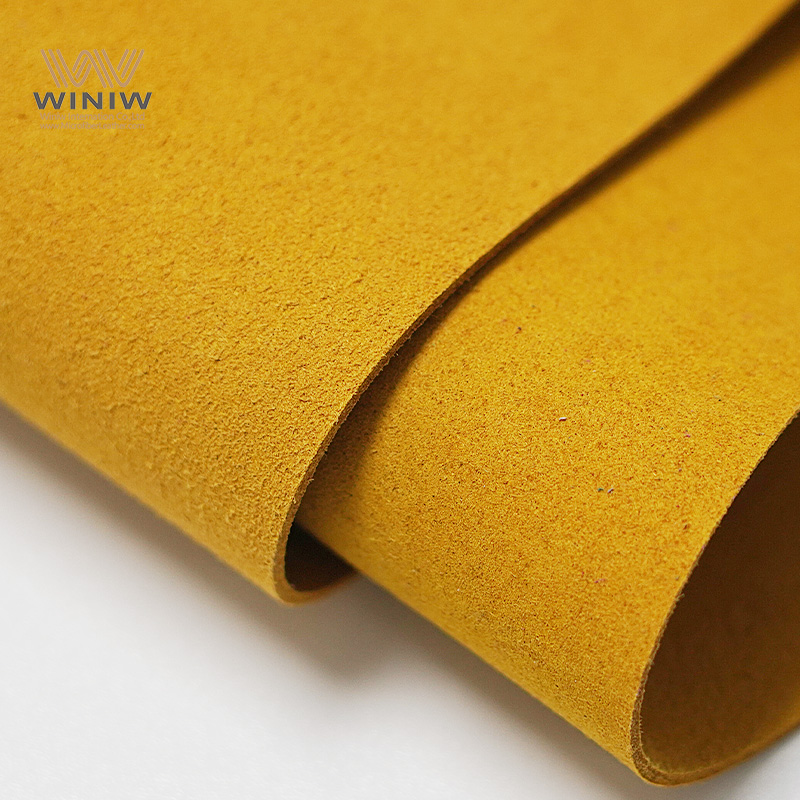
Real suede stands out in the fashion industry for its soft texture, lightweight feel, and elegant appearance. Designers often select suede for garments that blend style and comfort. This material adapts to both classic and modern aesthetics, making it a timeless choice for many applications.
Statement outerwear, such as jackets and coats, often feature real suede for a luxurious finish.
Bohemian-inspired dresses and skirts use suede to add a unique touch.
Elevated basics, including pants and shorts, benefit from the supple nature of real suede.
Accessories such as handbags, shoes, aprons, and belts showcase the versatility of suede.
Suede leather remains a preferred option for those seeking a blend of tradition and sophistication. Many designers incorporate suede into a wide range of garments and accessories, highlighting its adaptability. Real suede suits occasions where luxury and tactile experience matter most. High-end fashion, bespoke accessories, and classic footwear often rely on the authentic look and feel of real suede.
Tip: Choose real suede for projects that require a premium finish and a unique, natural texture. Items intended for special occasions or statement pieces benefit from the elegance of suede.
Individuals who value authenticity and craftsmanship gravitate toward real suede. This material appeals to those who appreciate the tactile sensation and subtle variations found in natural leather. Real suede attracts consumers who prioritize style, tradition, and luxury in their purchases.
The following groups often prefer real suede:
|
Consumer Group |
Preference Reason |
|---|---|
|
Fashion-conscious individuals |
Seek luxury and timeless style |
|
Professionals |
Value classic accessories and footwear |
|
Younger demographics |
Interested in both classic and modern styles |
|
Men’s segment |
Significant interest in Chelsea boots and belts |
Younger consumers, including millennials and Gen Z, often prioritize sustainability, quality, and personalization. These groups look for products that align with their values, favoring materials that offer both style and substance. The men’s segment in North America shows strong demand for suede Chelsea boots, driven by fashion trends and professional needs. Pop culture and social media influence younger buyers, encouraging them to explore both traditional and contemporary uses of real suede.
Block Quote: Real suede remains the material of choice for those who desire a blend of luxury, tradition, and personal expression. When to choose real suede depends on the need for authenticity and a premium tactile experience.
Consumers who seek a classic look and feel, or who want to invest in long-lasting, elegant pieces, find real suede to be the superior option. Those who prefer faux suede or other alternatives may prioritize ease of care or ethical considerations, but real suede continues to hold a special place in fashion and design.
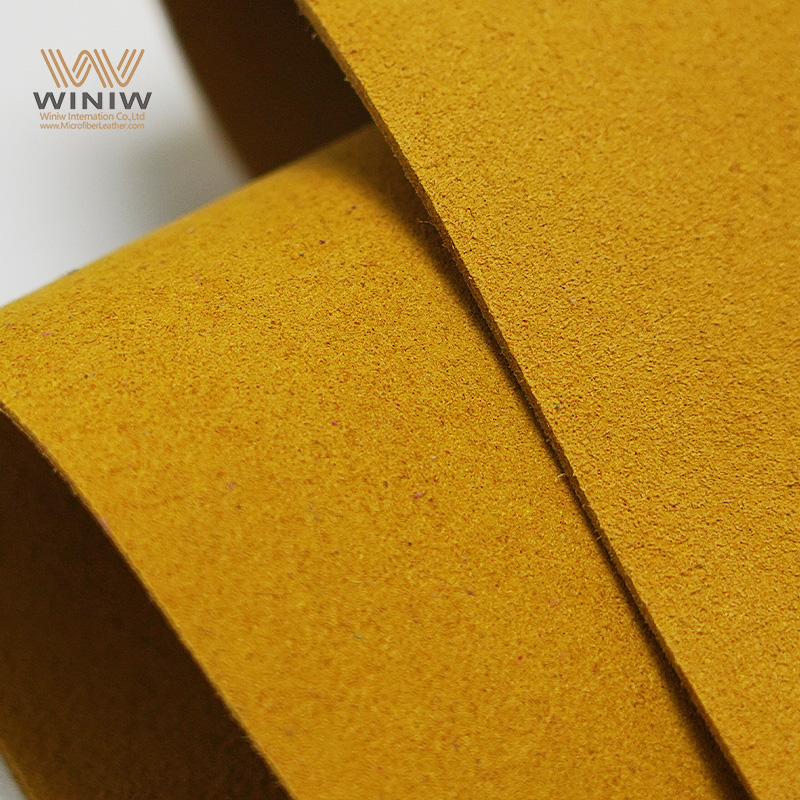
Many consumers encounter myths when choosing between microfiber suede, faux suede, and real suede. These misconceptions can influence purchasing decisions and lead to confusion about the qualities of each material.
Some believe that faux suede always looks and feels artificial. In reality, modern faux and microfiber options closely mimic the texture and appearance of real suede.
Many assume that real suede lasts longer than any synthetic alternative. However, microfiber and faux suede often outperform real suede in high-traffic or demanding environments.
A common myth suggests that faux suede is difficult to clean. The opposite holds true. Faux and microfiber suede resist stains and water, making them easier to maintain than real suede.
Some think that only real suede offers a luxurious finish. High-quality microfiber suede provides a soft, velvety touch and a consistent, upscale look.
There is a belief that faux suede frays or mats quickly. Manufacturers design modern microfiber and faux suede to resist fraying and matting, even with frequent use.
Many people overlook the affordability of faux and microfiber suede, assuming all suede products carry a premium price tag.
Many shoppers forget to consider their budget, lifestyle, and ethical preferences when choosing between real and faux suede. These factors play a significant role in finding the right material.
Understanding the facts about suede materials helps consumers make informed choices.
Faux suede, sometimes called "suedette," appeals to those seeking animal-friendly and vegan options. It offers a similar look and feel to real suede without using animal products.
Microfiber suede stands out for its tightly woven structure, which repels stains and water. This feature reduces the need for frequent washing and simplifies cleaning.
Real suede provides a unique, natural texture and subtle variations in color. Many view it as a high-quality investment piece, especially in luxury fashion and accessories.
Faux suede is generally more affordable than real suede. This makes it a practical choice for those who want style and durability without a high price.
Microfiber and faux suede maintain their appearance over time, resisting common issues like matting or fading. Real suede requires more care and is sensitive to water and stains.
Both faux and microfiber suede offer practical benefits for busy lifestyles, while real suede remains popular for its authenticity and tactile appeal.
Choosing between microfiber, faux, and real suede depends on individual priorities. Each material brings unique strengths to the table.
Selecting the right suede material depends on several key factors. Buyers should evaluate their priorities before making a decision. The following considerations often influence the choice between microfiber suede and real suede:
Affordability remains a primary concern for many consumers. Faux suede offers a cost-effective solution, making it accessible for those with budget constraints.
Animal-friendly options appeal to ethical shoppers. Faux and microfiber materials do not involve animal products, which aligns with the values of those seeking cruelty-free alternatives.
Durability plays a significant role in long-term satisfaction. Microfiber suede resists stains and wear, outperforming real suede in demanding environments.
Easy maintenance benefits busy households and commercial spaces. Microfiber requires minimal care, while real suede demands specialized cleaning.
Variety in color and texture allows for creative freedom. Microfiber provides a broader range of design choices compared to natural suede.
Intended application guides the selection process. Upholstery, clothing, accessories, automotive interiors, and bedding each have unique requirements.
Tip: Buyers should list their top priorities before choosing a material. This approach ensures the final selection matches both practical needs and personal values.
Matching the right suede to specific needs involves understanding how each material performs in different scenarios. Microfiber suits environments where durability and easy cleaning matter most. Upholstery for sofas and chairs benefits from the stain resistance and longevity of microfiber. Automotive interiors require materials that withstand frequent use and exposure to moisture, making microfiber an ideal choice.
Fashion-conscious individuals often prefer real suede for its luxurious texture and authentic appearance. Jackets, skirts, and pants made from real suede offer a stylish look that stands out. Accessories such as handbags, wallets, and belts showcase the versatility of both real and faux suede, allowing buyers to select based on their ethical and budget preferences.
Households with children or pets find microfiber suede practical for bedding and decorative pillow covers. The material resists spills and maintains its appearance with minimal effort. Faux suede provides a fashionable alternative for those who want style without sacrificing convenience.
The following table summarizes how different priorities align with each material:
|
Priority |
Best Material |
Reason |
|---|---|---|
|
Budget |
Faux suede |
Lower cost, accessible to more consumers |
|
Ethical sourcing |
Microfiber suede |
No animal products, cruelty-free |
|
Durability |
Microfiber |
Resists stains, wear, and fading |
|
Luxury and authenticity |
Real suede |
Unique texture, premium appearance |
|
Easy maintenance |
Microfiber suede |
Simple cleaning, minimal upkeep |
|
Design variety |
Microfiber suede |
Wide range of colors and textures |
Block Quote: The best choice depends on individual priorities. Buyers should consider cost, ethics, durability, maintenance, and style before selecting suede for any application.
Microfiber suede delivers durability, easy cleaning, and avoids ethical concerns, while real suede offers luxury and natural richness but needs careful maintenance. Each type of suede fits different priorities. Shoppers should consider appearance, upkeep, and values before choosing faux suede, microfiber, or real options. For further exploration, readers can look into:
Ultrasuede, a non-woven fabric that mimics real suede
Genuine suede types like cowhide, sheepskin, and goatskin
Faux alternatives such as microsuede and sueded cotton
The best material depends on personal style, lifestyle, and ethical preferences.
Microfiber suede uses synthetic fibers to mimic the look and feel of real suede. Real suede comes from animal hides. Microfiber suede offers better durability and easier maintenance. Real suede provides a unique, natural texture and appearance.
Yes, microfiber suede works well for upholstery and car interiors. The material resists stains and wear. Faux Leathers' micro fiber leather provides a durable, stylish option for high-traffic areas.
Cleaning microfiber suede requires only a damp cloth for most stains. For tougher spots, use mild soap. Avoid harsh chemicals. The material dries quickly and maintains its appearance with minimal effort.
Microfiber suede, especially from Faux Leathers, uses eco-friendly production methods. The material contains no animal products and often includes recycled content. This makes it a sustainable choice for consumers concerned about environmental impact.
Yes, real suede needs special care. Owners should use a suede brush and specific cleaning products. Water and stains can damage real suede. Professional cleaning may be necessary for tough stains.
Microfiber suede resists dust and allergens better than real suede. The tightly woven fibers prevent particles from settling. This makes microfiber suede a good choice for allergy-sensitive individuals.
Manufacturers can produce microfiber suede in a wide range of colors and textures. Faux Leathers' micro fiber leather closely matches the appearance and feel of real suede, offering consistent results for design projects.
Consumers can purchase Faux Leathers' micro fiber leather directly from the official website: https://www.faux-leathers.com/. The site offers detailed product information and support.